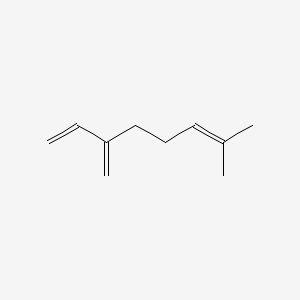| Authors | Title | Published | Journal | PubMed Link |
|---|---|---|---|---|
| Cai GX et al. | Comparative analysis of essential oil components of Evodia rutaecarpa (Juss.) Benth. var. officinalis (Dode) Huang and Evodia rutaecarpa (Juss.) Benth. | 2012 | Nat. Prod. Res. | pmid:22007871 |
| Verma RS et al. | Volatile constituents of Origanum vulgare L., 'thymol' chemotype: variability in North India during plant ontogeny. | 2012 | Nat. Prod. Res. | pmid:22011270 |
| Quartu M et al. | Effect of acute administration of Pistacia lentiscus L. essential oil on rat cerebral cortex following transient bilateral common carotid artery occlusion. | 2012 | Lipids Health Dis | pmid:22239952 |
| Aros D et al. | Volatile emissions of scented Alstroemeria genotypes are dominated by terpenes, and a myrcene synthase gene is highly expressed in scented Alstroemeria flowers. | 2012 | J. Exp. Bot. | pmid:22268153 |
| Lüddeke F and Harder J | Enantiospecific (S)-(+)-linalool formation from beta-myrcene by linalool dehydratase-isomerase. | 2011 Jul-Aug | Z. Naturforsch., C, J. Biosci. | pmid:21950166 |
| Aiemsaard J et al. | The effect of lemongrass oil and its major components on clinical isolate mastitis pathogens and their mechanisms of action on Staphylococcus aureus DMST 4745. | 2011 | Res. Vet. Sci. | pmid:21316719 |
| Caballero-Gallardo K et al. | Repellent activity of essential oils and some of their individual constituents against Tribolium castaneum herbst. | 2011 | J. Agric. Food Chem. | pmid:21291237 |
| Niazmand S et al. | Cardiovascular effects of Teucrium polium L. extract in rabbit. | 2011 | Pharmacogn Mag | pmid:21969799 |
| Bevilacqua A et al. | Use of essential oils to inhibit alicyclobacillus acidoterrestris: a short overview of the literature. | 2011 | Front Microbiol | pmid:21991262 |
| López MA et al. | Chemical composition and antigenotoxic properties of Lippia alba essential oils. | 2011 | Genet. Mol. Biol. | pmid:21931523 |
Myrcene
Myrcene is a lipid of Prenol Lipids (PR) class. Myrcene is associated with abnormalities such as Hypomenorrhea, abnormal fragmented structure, Nephrosis, Renal tubular disorder and Kidney Diseases. The involved functions are known as Anabolism, Gene Expression, Protein Biosynthesis, Mutation and Selection, Genetic. Myrcene often locates in Plastids, Proboscis, Body tissue, Clone and soluble. The associated genes with Myrcene are TTPA gene, monoterpene synthase, Genome, 4S-limonene synthase and Homologous Gene. The related lipids are Pinene, Octanols, Membrane Lipids and Fatty Acids, Unsaturated.
Cross Reference
Introduction
To understand associated biological information of Myrcene, we collected biological information of abnormalities, associated pathways, cellular/molecular locations, biological functions, related genes/proteins, lipids and common seen animal/experimental models with organized paragraphs from literatures.
What diseases are associated with Myrcene?
Myrcene is suspected in Nephrosis, Kidney Diseases, Dehydration, Hypomenorrhea, Renal tubular disorder and other diseases in descending order of the highest number of associated sentences.
Related references are mostly published in these journals:
| Disease | Cross reference | Weighted score | Related literature |
|---|
No disease MeSH terms mapped to the current reference collection.
PubChem Associated disorders and diseases
What pathways are associated with Myrcene
There are no associated biomedical information in the current reference collection.
PubChem Biomolecular Interactions and Pathways
Link to PubChem Biomolecular Interactions and PathwaysWhat cellular locations are associated with Myrcene?
Visualization in cellular structure
Associated locations are in red color. Not associated locations are in black.
Related references are published most in these journals:
| Location | Cross reference | Weighted score | Related literatures |
|---|
What functions are associated with Myrcene?
Related references are published most in these journals:
| Function | Cross reference | Weighted score | Related literatures |
|---|
What lipids are associated with Myrcene?
Related references are published most in these journals:
| Lipid concept | Cross reference | Weighted score | Related literatures |
|---|
What genes are associated with Myrcene?
Related references are published most in these journals:
| Gene | Cross reference | Weighted score | Related literatures |
|---|
What common seen animal models are associated with Myrcene?
There are no associated biomedical information in the current reference collection.
